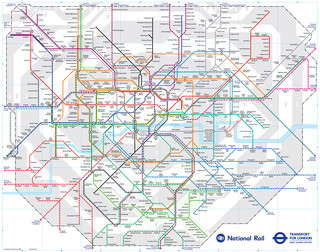You can find on this page the map of London suburban train, the map of London overground, the map of London DLR, the map of London Crossrail, the map of the South West Trains, the map of the First Capital Connect, the map of the Southern Railway, the map of the C2C, the map of the First Great Western, the map of the Chiltern Railways, the map of the Abellio Greater Anglia, the map of the Southeastern Railway and the map of the Heathrow Connect. These 12 urban, suburban and communter train networks are a transit system serving the city of London (United Kingdom) with the tube, the tram, the bus, the nigth bus or the river bus. These 12 commuter train networks have 52 lines and 1,325 stations forming a rail network of 2,671 miles (4,300 km).
London Rail Map
 London rail map
PrintDownload PDF
London rail map
PrintDownload PDF
The London urban, suburban and communter trains network is gathering several train networks.
Its network includes the following 12 networks:
• London Overground
• Docklands Light Railway (DLR)
• Crossrail
• South West Trains
• First Capital Connect
• Southern Railway
• C2C
• First Great Western
• Chiltern Railways
• Abellio Greater Anglia
• Southeastern Railway
• Heathrow Connect




